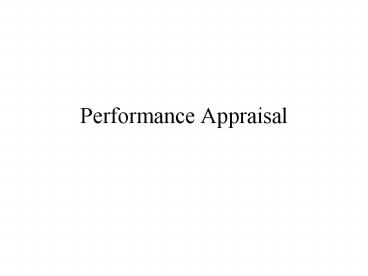Performance Appraisal - PowerPoint PPT Presentation
1 / 20
Title:
Performance Appraisal
Description:
Assign appropriate proportions of people to each performance category ... Customers/clients/suppliers. Performance Appraisal: Interview. Purpose ... – PowerPoint PPT presentation
Number of Views:1011
Avg rating:3.0/5.0
Title: Performance Appraisal
1
Performance Appraisal
2
Objectives (for class responsible for objectives
in book as well)
- Understand performance appraisal's (PA) role in
control systems and which control systems (I.e.,
reasons for PA). - Understand the dimensions of criteria, the
elements of procedural justice and the types of
bias. - Know 3 types of comparisons methods and BARS and
the research on each. - Know the main considerations for determining who
should do PA and the basic findings regarding
each. - Understand why we give a performance interview
and the mixed model approach.
3
Overview
- Why
- Issues
- How
- Who
- PA interview
4
Performance Appraisal Why
- Provides sensory input into organizational,
individual, and evaluation control systems. - Personnel decisions.
- Merit pay.
- Promotions.
- _________________
- Employee development.
- ____________
- Goal setting.
- Feedback.
- Research.
- Criterion for _________________
- Training evaluation, etc.
- The purpose effects design, employee and rater
reactions.
5
Performance Appraisal Issues
- Good criteria
- Relevance reliability _____________________
- Practicality
- development costs
- usage costs time, kind degree of monitoring
(see next) - face validity subordinate supervisor
____________ - Use
- Merit pay
- Promotion
- Development
- Research
6
Everyone hates it (yet want the results)
- Procedural v. distributive justice
7
Rating Exercise
Think of four professors that you had last term.
Write down their names in the places below and
than rate each professor on the five dimensions.
- Professor C _________________
- Knowledge of subject 1 2 3 4 5
- Fairness of grades 1 2 3 4 5
- Organization 1 2 3 4 5
- Speaking skills 1 2 3 4 5
- Interest in students 1 2 3 4 5
- Professor D _________________
- Knowledge of subject 1 2 3 4 5
- Fairness of grades 1 2 3 4 5
- Organization 1 2 3 4 5
- Speaking skills 1 2 3 4 5
- Interest in students 1 2 3 4 5
- Professor A _________________
- Knowledge of subject 1 2 3 4 5
- Fairness of grades 1 2 3 4 5
- Organization 1 2 3 4 5
- Speaking skills 1 2 3 4 5
- Interest in students 1 2 3 4 5
- Professor B _________________
- Knowledge of subject 1 2 3 4 5
- Fairness of grades 1 2 3 4 5
- Organization 1 2 3 4 5
- Speaking skills 1 2 3 4 5
- Interest in students 1 2 3 4 5
8
Bias
- System
- _______________ bias
- ______________________ bias
- Group characteristic bias (stereotyping)
- Similar-to-me liking
- Age, gender, race, time (fad)
- _____________________
- Rating biases
- ________
- Central tendency, ____________
- Order effects
- Negativity
9
Preventive measures
- Job analysis
- ________________
- frequent observation documentation
- make correction post hoc
- make PA part of raters' PA
- scale/method development
10
Performance Appraisal How
- Graphic rating scales
- bias and rating errors high
- Cheep easy
- Semi-useful for _________________
except- tionally good
above average
below average
average
poor
11
Employee Comparison
- In general
- rating bias eliminated
- merit promotion information high but
development information is nil
12
Comparison Methods
- Rank-order
- difficult to rate middle performers
- difficult ______________
- Paired-comparison
- tedious w/ numerous dimension lots of
subordinates - (n x (n 1))/2
- E.g., _______________________________
13
Paired Comparson
- Consider overall job performance answer the
following questions - Is Sue K. better than John L. _________
- Is Sue K. better than Harold S. _________
- Is Sue K. better than Janet N. _________
- Is John L. better than Harold S. _________
- Is John L. better than Janet N. _________
- Is Janet N. better than Harold S._________
14
Forced DistributionPerformance
Assign appropriate proportions of people to each
performance category
15
Behavioral Checklists and Scales
- In general
- good information for _______________
- may provide good information for other uses
- High development costs
- reduces bias
- rating error still problem (motivation seems key
issue) - All begin with __________________________
16
Behavioral Methods
- Behavioral observation scales (BOS)
- Frequency scores
- Provides additional information but more onerous
(rarely used) - Behaviorally Anchored Rating Scale
17
BARS Meeting day-to-day deadlines
- 9. Could be expected never to be late in meeting
deadlines, no matter how unusual the
circumstances. - 7. Could be expected always to get associates
work schedules made out on time. - 5. Could be expected to offer to do the orders
at home after failing to get them out on the
deadline day. - 3. Could be expccted to be late all the time on
weekly buys for his/her department. - 1. Could be expected to leave order forms in the
desk drawer for several weeks even when they had
been given to the manager by the buyer after
calling attention to short supplies and due dates
for orders.
18
Performance Appraisal Who
- Criteria _________________________________
- Supervisor
- Self
- Leniency
- Developmental
- Peers
- Unpopular
- Can be accurate
- Customers/clients/suppliers
19
Performance Appraisal Interview
- Purpose
- Inform of results - use for personnel decisions
(e.G., Promotion), merit pay - procedurally just - Developmental
- Approach mixed model
- Ask for self-pa
- Tell results
- -
20
What I/O Psychologists do regarding PA
- Analyze job
- Develop instrument and feedback system
- usually __________
- _______________
- Develop conduct rater training
- Research problems































